You’ve got clues that show your prospect’s buying intention, crafted great content, and reached out but conversions still aren’t where they should be.
The problem? You may be talking to the wrong people at the wrong time, leaving sales opportunities on the table. So, how do you avoid this?
In this guide, you will learn how to identify and use intent signals to boost your sales and marketing efforts effectively.
What are Intent Signals?
Intent signals, also known as buying signals or intent data, are hints that show a potential customer’s interest in buying your products or services. These signals help identify when a potential customer needs a product or service, researches the solution, and considers making a purchase.
Website visits. Hiring intent. Expansion or relocation to a new site. Layoffs. Merger or acquisitions. New executives. Funding rounds. New tech stack integrations.
These are all examples of intent signals. Sales and marketing teams can leverage these signals to identify potential customers, initiate sales conversations, and make informed decisions.
What are the Commonly Used Types of Intent Signals?
Intent signals are of three main types which include:
First-Party Intent Data: These are data collected from your own GTM ecosystem. They include activities like content downloads, website visits, product usage, webinar registrations, email engagement, and more.
Second-Party Intent Data: These insights are collected from partner agencies or outside news sources. They can be from review sites like G2, champion tracking platforms, and more.
Third-Party Intent Data: This intent data is gathered from external sources to provide a wider view of an account’s online activity. Examples include social engagement, search trends, public web browsing data, and more.
Forms of Intent Signals
Intent signals exist in different forms with each offering unique insights and perspectives into the user’s behavior. These forms include:
Engagement Intent Signals
These signals refer to the specific actions that show your prospects have interacted with a particular content on your website. They include likes, comments, shares, follows, or downloads.
An example is when your prospect downloads a research whitepaper from your site. That signals that your brand is on top of their mind. With this insight, you can craft a personalized sales strategy to cater to your prospect’s interests and needs.
Research Intent Signals
These signals indicate the kind of solution your prospect is actively searching for online. They show the topics your prospects are researching and reflect their buying stage. These valuable insights provide a roadmap to engage and follow up with your potential buyers.
For instance, let’s say you are an email marketer and you notice your prospect searching for “best email marketing software.” This shows they are no longer in the awareness stage but in consideration. You can leverage this information to position your brand as a potential solution.
Hiring Intent Signals
Hiring intent indicates the available job positions within a particular brand. If a company is hiring for different positions, it shows they’re seeking a solution in that area and are willing to spend money.
Suppose a company is searching for expertise with keywords like web developers, which could indicate that it intends to scale its web technologies.
Technographic Intent Signals
These signals show the technology stack a company uses. You can use it to identify when they started to use a particular technology or stopped using one. For instance, if a company uses platforms like LinkedIn to find leads, that could indicate they’re looking for data enrichment services or outreach tools to scale their sales operations.
Firmographic Intent Signals
Firmographic signals reveal valuable insights about a company. It includes information like company size, location, annual revenue, employee count, funding rounds, an upcoming event, and more.
These signals often indicate changes within the organization and depending on its type, show they are willing to spend money. For instance, if a company conducted a fundraising round, that shows they are ready to spend some money.
How to Use Intent Signals in B2B Sales?
Intent signals become super valuable when you integrate with your go-to-market strategy. Here are five ways that marketing and sales teams can use intent signals to boost your B2B sales efforts.
1. Collect and Determine the Most Relevant Signals
Let’s face it. Working with all the signals you get from different tools will overwhelm and confuse you. In fact, the influx of signals could make it a bit difficult to identify and choose the right one that boosts your sales efforts.
2. Identify and Qualify Leads
Now that you’ve determined the most relevant signals, use them to identify and find qualified leads. Your potential leads should align with your ICP. They are people who have interests or are actively researching your solutions, industry, or competitor’s products. This process enables you to know who you’re targeting.
Qualify the leads based on the signal’s strengths. Leads with first-party signals like website visits require the utmost attention. Assign scores on each lead to prioritize your sales efforts.
3. Personalize Your Messages
A generic, one-size-fits-all sales pitch doesn’t speak directly to the challenges and needs of your prospects. As a result, there is a need to personalize their experiences.
You can leverage intent data to enhance personalization to fit your prospect’s unique preferences and behavior.
4. Reach Out at the Right Time
If you reach out to a lead with high intent at the wrong time, you may not close the deal. Timing is crucial when using intent signals. Reaching out to your prospects at the precise moment increases your likelihood of getting a positive response and converting your prospects.
5. Follow Up on Prospects
You can also use intent signals to follow up on prospects and boost your sales outreach efforts. This approach helps to address their potential concerns and nurture relationships, increasing the chances of conversion.
Intent Signal Tools for Your B2B Business
Tracking intent signals manually is a time-wasting and tedious process. In this section, we explore some signal tools that provide these valuable data automatically to supercharge your marketing and sales efforts.
1. Clay
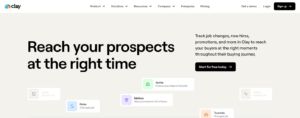
Although Clay is famous for its data enrichment services, it offers intent data to reach relevant prospects. Clay tracks buying signals across the entire market to reach your ideal buyers at the right moment.
For instance, you can get messages when someone changes their job, alert on new hires, or monitor when a prospective customer gets relevant promotions. With your signals identified, Clay pushes them to sync with your CRM and keep your data up-to-date.
Key Features
- Clay tracks and provides your sales team with intent data.
- It syncs signals with your CRM to keep your database updated and relevant.
2. Instantly
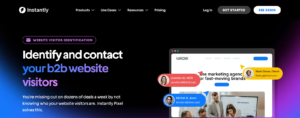
If you don’t want to miss out on high-value prospects who visit your website, we suggest using Instantly. Instantly unveils detailed information about your web visitors, ensuring you reach them and close deals.
You can get details like your prospect’s full name, business email address, company name, or LinkedIn profile to contact them easily. The sales engagement platform pushes these details to Slack to boost your outreach campaign and optimize your sales process.
Instantly also offers advanced filters to sort your web visitors and reveal the relevant prospects. This approach ensures you focus on the most promising prospects who are more likely to convert for your business.
Key Features
- A web visitor identification feature deanonymizer your unknown visitors and provides their contact details.
- It integrates with Slack for an effective outreach campaign.
- Its advanced filters allow you to segment your web visitors and focus on the most relevant prospects.
3. Lemlist
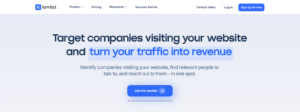
Lemlist is another intent signals platform that boosts your sales efforts. With its web visitor identification feature, you can recognize the companies landing on your site and convert the traffic into revenue. All you need to do is to install a website tracking script for the software to identify your web visitors accurately. It provides details of European and US-based companies directly into Lemlist’s B2B database feature.
Besides, Lemlist’s smart filtering feature allows you to find relevant people from your web visitors list. This approach allows you to segment your leads effectively, creating a targeted outreach campaign.
You can perform other tasks like email verification or multichannel outreach sequences to increase your chances of converting your web visitors. Lemlist integrates with various tools like CRMs, data enrichment platforms, and workflow tools to drive efficiency.
Key Features
- A web visitor identification feature that deanonymizes your web visitors and ensures you don’t miss out on sales opportunities.
- A smart filtering feature that segments your leads and ensures you target the right people
- Integrations with CRMs, data enrichment, or workflows to maximize efficiency.
6. RB2B
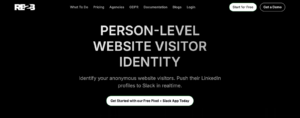
Need to identify your website visitors? RB2B is your best shot. The web visitor identification software deanonymizer the visitors landing on your website. It provides information like contact details, job titles, and LinkedIn profile URLs and pushes the information to Slack. With this approach, you don’t get to miss out on sales opportunities that could contribute to your business’s revenue.
RB2B only works for US-based visitors. In other words, it doesn’t target European web visitors or obtain their data. It’s compliant with regulatory bodies such as GDPR, CCPA, and CPRA.
Key Features
- RB2B identifies anonymous website visitors.
- It obtains your visitors’ information and pushes them to Slack.
- It works for US-based visitors.
8. Trigify
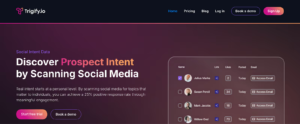
If you’re interested in getting social signals, Trigify might be your favorite. This platform scans social media sites for intent data to drive meaningful engagement to your campaigns. For instance, you can identify topics your prospects are interacting with and tailor your outreach strategy. You can also research competitors with similar offerings to find your ideal buyers.
Trigify offers personalized data to drive hyper-personalized campaigns that resonate with your audience. It also watches out for conversations within your industry to keep updated on recent happenings.
Key Features
- It discovers engagement trends to connect with your ideal audience.
- It offers personalized data to drive targeted campaigns.
- It tracks conversations in your industry to keep you informed and engaged.
Partner with Prospects Hive to Use Intent Signals and Drive Real Results Effectively
Identifying the right signals that can propel your sales efforts can be challenging. After all, your ideal buyers are actively researching your solutions but you’re not tapping into those opportunities effectively.
However, with Prospects Hive, you don’t have to worry about all these processes. Our sales team utilizes efficient technologies to spot buying signals that convert these potential leads into paying customers. We identify high-value clients for your business and personalize the marketing campaign to speak with your prospect’s needs directly.
Get in touch with us today to get started!




